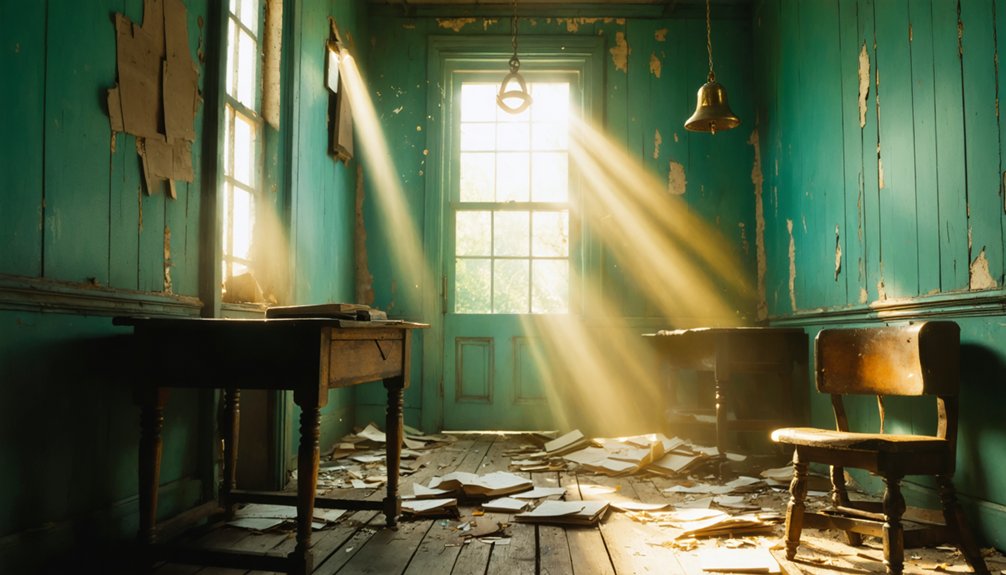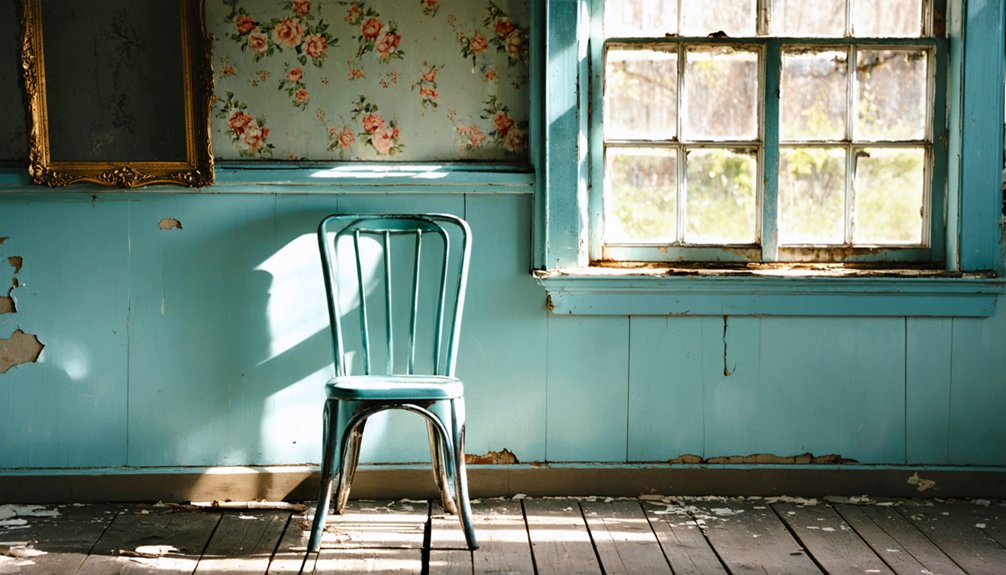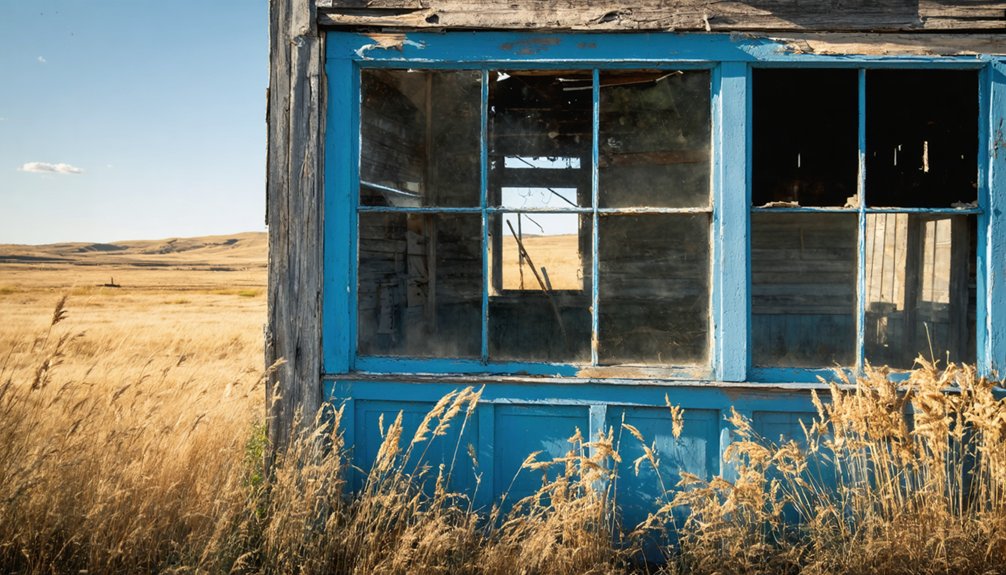You’ll find South Dakota’s most fascinating ghost towns scattered across the Black Hills and prairies, from Ardmore’s toxic legacy along Highway 71 to Spokane’s silver mining ruins 16 miles from Custer. Don’t miss Galena’s 1875 architecture or the Prairie Homestead’s authentic frontier buildings. While some towns like Okaton maintain a handful of residents, others stand completely abandoned. These haunting settlements hold countless untold stories of fortune-seekers, pioneers, and determined souls who shaped the American West.
Key Takeaways
- Ardmore’s abandoned buildings and toxic water issues highlight the environmental challenges that led to its ghostly status.
- Spokane’s silver mining heritage peaked in 1927 with $114,000 in ore shipments before declining into abandonment by mid-1980s.
- The Homestake Mine, founded after Custer’s 1874 gold discovery, operated for 126 years in the Black Hills region.
- Historic preservation efforts in Galena feature guided ghost town walks and restoration projects managed by local societies.
- Buffalo Gap and Prairie Homestead offer well-preserved frontier structures that showcase authentic 1870s architecture and ranch life.
Haunting Tales From Ardmore’s Final Days
While most ghost towns fade quietly into history, Ardmore’s final chapter is marked by particularly haunting stories that continue to captivate visitors and historians alike.
You’ll find the town’s eerie remnants scattered along Highway 71, where decaying frontier buildings and rusted vehicles stand as silent witnesses to its slow demise. The haunting atmosphere intensifies when you consider how the town’s residents struggled against toxic water and relentless drought before finally surrendering to the harsh environment. The acidic Hat Creek made survival nearly impossible for the remaining residents. National Geographic featured the ghostly town in a compelling 2004 expose.
Even President Coolidge’s historic picnic spot now carries an unsettling air of abandonment. Today, you’ll encounter “No Trespassing” signs and protective barriers around Ardmore’s ghostly structures, where reports of unusual sightings and animal remains add to the town’s reputation for otherworldly encounters.
Hidden Gems of the Black Hills Ghost Circuit
You’ll discover fascinating mining claims and abandoned camps scattered throughout the Black Hills, from the eerily preserved schoolhouse in Galena to the water-locked remnants of Camp Crook beneath Pactola Lake.
The historic railroad town of Mystic offers some of the region’s best-preserved original buildings, including its meticulously restored schoolhouse that once served the bustling mining community. Just like the spirits reported at the Hotel Alex Johnson, visitors often report unexplained phenomena in these historic structures. The town’s Mystic Reduction Mill, demolished in 1913, marked the beginning of its eventual decline.
Along Vanocker Canyon and Little Rapid Creek, you can explore enduring structures like Rochford’s Moonshine Gulch Saloon and the Irish Gulch Dance Hall, which stand as evidence to the area’s rich mining heritage.
Mining Claims and Camps
During the Black Hills gold rush of the 1870s, mining claims and camps sprang up rapidly following Lieutenant Colonel Custer’s 1874 discovery of gold near French Creek. The Kiowa and Crow tribes originally inhabited these lands before the mining boom began.
You’ll find the most famous claim was staked by the Manuel brothers, who founded the legendary Homestake Mine near Lead – a site that would produce gold for an incredible 126 years. San Francisco investors led by George Hearst would later purchase the claim for $70,000, transforming it into one of America’s richest gold mines.
- From French Creek to Deadwood, you’ll discover ghost camps that once bustled with prospectors seeking their fortune in both placer and hard-rock mining.
- Mining claims ranged from single stakes to massive operations like Golden Reward’s 3,400-acre empire.
- You can still explore abandoned mining claims throughout the region, where powder houses and old mill ruins tell tales of boom-and-bust cycles that shaped the Black Hills.
Historic Railroad Town Ruins
As railroads carved their way through the rugged Black Hills terrain in the late 1800s, they established a network of towns that now stand as fascinating ruins along abandoned rail corridors.
You’ll find railroad remnants scattered throughout historic stops like Tunnel, north of Deadwood, where one of the region’s most durable privies still stands among old house foundations.
For the ultimate ghost town exploration, follow the old Warren-Lamb logging routes, where rails once climbed impossible 34% grades.
Visit Trojan’s junction ruins, or trek to Moskee’s deserted streets. In Spokane, 16 miles from Custer, you can trace the paths where trains once hauled precious ore. The schoolhouse remained funded until 1927, marking the town’s prosperity. The decline of these towns accelerated when trucking replaced railroads for shipping cattle and goods.
Look for sunken depressions where crossties rotted away and rusted spikes – silent witnesses to the Black Hills’ railroad heritage.
Preserved Buildings Worth Visiting
While many Black Hills ghost towns have crumbled into ruins, several historic settlements still showcase remarkably preserved buildings that tell vivid stories of the region’s mining and pioneer past.
You’ll find some of the most impressive preserved structures in Spokane, where original mining-era buildings stand as silent witnesses to the gold and silver boom days. Many sites now exist in various states of disrepair, representing different stages of abandonment across the region. The iconic collapsing church in Capa stands as a haunting reminder of the town’s 300-person peak population.
- Galena’s intact silver mining buildings offer authentic glimpses into 1875 boom-town architecture and early mining practices.
- Prairie Homestead’s original frontier structures near Philip perfectly capture the essence of pioneer life.
- Buffalo Gap’s historic ranch buildings and preserved western architecture transport you back to the 1877 cattle town era.
These historically significant sites aren’t just tourist stops – they’re portals into the untamed spirit of Black Hills settlement history.
Life in Okaton: Where Time Stands Still
Since its founding in 1906, Okaton has embodied the quintessential story of America’s prairie railroad towns – from bustling promise to quiet abandonment.
You’ll find Okaton memories etched in every weathered building and abandoned rail track. What was once a thriving community of railroad workers and homesteaders now stands frozen in time. The railroad legacy lives on through the deteriorating wooden grain elevator and overgrown tracks, silent witnesses to bygone prosperity.
In the 1980s, you might’ve stopped at Westlake’s Ghost Town for gas or visited their petting zoo, but today these tourist attractions lie dormant. While about 31 residents still call the surrounding farmland home, the village itself remains largely deserted, offering a haunting glimpse into the harsh realities of prairie life and the impact of changing times.
Photographing South Dakota’s Abandoned Places

What draws photographers to South Dakota’s abandoned places? It’s the haunting beauty of ghostly landscapes frozen in time – weathered grain elevators reaching skyward, crumbling brick storefronts telling tales of boom-and-bust cycles, and lonely church steeples standing sentinel over empty prairies.
For capturing abandoned photography in South Dakota’s ghost towns, remember these essential tips:
- Scout locations like Okaton and Cottonwood where historic structures offer dramatic subjects, from tiny jails to defunct railroad tracks.
- Respect private property – many sites require permission and careful navigation of posted areas.
- Visit during off-peak seasons when soft light illuminates textured ruins, and fewer tourists disrupt your shots.
Let the decaying architecture and forgotten relics guide your lens through stories of pioneer dreams, mining fortunes, and the inevitable march of time across the Plains.
Mining Towns That Vanished: The Spokane Story
The ghost town of Spokane stands as a tribute to South Dakota’s rich mining heritage, tucked away 16 miles northeast of Custer in the rugged Black Hills.
You’ll find this forgotten treasure’s story begins in 1890 when the Judd family struck silver-lead ore, sparking a mining boom that would last nearly 50 years.
During its heyday in 1927, the mine shipped over $114,000 worth of ore – equivalent to $150,000 today.
But like many mining towns, Spokane’s history took a downturn when the precious metals ran dry.
By the 1940s, mining decline had set in, and the last resident – a watchman – departed in the mid-1980s.
Today, you can explore the deteriorating schoolhouse, watchman’s house, and scattered ruins that whisper tales of this once-thriving community.
Last Residents: Stories From Near-Empty Towns

Living quietly among the decaying structures of South Dakota’s ghost towns, a resilient few residents maintain their homes and lives in near-empty communities like Capa and Okaton.
In these nearly abandoned places, you’ll find last resident stories that speak of deep connections to family heritage and unwavering determination to preserve their way of life.
- Capa’s sole inhabitant lives in an ancestral home, standing guard over a town that once bustled with 300 residents.
- Okaton’s remaining 31 residents maintain their properties despite the departure of essential services.
- Cottonwood’s dozen inhabitants keep their town’s legacy alive through personal dedication.
These ghost town memories aren’t just about empty buildings – they’re about the fierce independence of those who’ve chosen to stay, maintaining their freedom and connection to places that shaped South Dakota’s history.
Preserving the Past: Ghost Town Restoration Projects
Since falling into disrepair decades ago, South Dakota’s historic ghost towns have found new life through dedicated restoration projects that preserve their rich cultural heritage.
You’ll find passionate volunteers and local historical societies working tirelessly on ghost town preservation, from stabilizing old grain elevators to refurbishing historic churches and homes.
Community involvement drives these efforts forward, with modest budgets around $13,000 making every donation count.
Local groups stretch every dollar to save these historic treasures, proving passionate volunteers can achieve remarkable results on shoestring budgets.
Events like the Galena Ghost Town Walk connect you to mining camp histories through guided tours, while organizations like The Galena Society coordinate restoration work and public outreach.
You can experience these living museums firsthand, where carefully restored landmarks and interpretative programming bring pioneer stories to life.
These preservation efforts guarantee South Dakota’s frontier legacy endures for future generations to explore and appreciate.
Frequently Asked Questions
Are There Any Ghost Towns in South Dakota Accessible by Public Transportation?
You can’t reach South Dakota’s ghost towns by public transport – you’ll need your own wheels. Even popular spots like Rockerville near Mount Rushmore lack bus service or ghost town tours.
What Survival Gear Should You Bring When Exploring South Dakota Ghost Towns?
You’ll need survival essentials like protective gear, sturdy boots, first aid kit, GPS, flashlights, water, food, multi-tool, and communication devices. Don’t forget dust masks for abandoned building exploring.
Which Ghost Towns Allow Metal Detecting or Artifact Collecting?
You’ll need proper metal detecting permits for any ghost town in South Dakota. Artifact collecting’s generally prohibited – but you can legally detect at Okaton with landowner permission and following state laws.
Do Any South Dakota Ghost Towns Host Paranormal Investigation Events?
Where there’s smoke, there’s fire! You’ll find ghost hunting opportunities in Deadwood’s historic locations, including guided paranormal tours at Broken Boot Mine, Adams House, and Fairmont Hotel during their annual Ghosts of Deadwood event.
Can You Legally Purchase Property in South Dakota’s Abandoned Towns?
You can purchase ghost town property through tax deed sales or public auctions. Watch for legal restrictions and be ready to file quiet title actions to secure your ownership rights.
References
- https://www.powderhouselodge.com/black-hills-attractions/fun-attractions/ghost-towns-of-western-south-dakota/
- https://www.youtube.com/watch?v=_0WNYsFLSLA
- https://b1027.com/south-dakota-has-an-abundance-of-ghost-towns/
- https://kxrb.com/the-creepiest-ghost-towns-in-all-of-south-dakota/
- https://www.blackhillshikingbikingandmore.com/old-mining-ghost-towns
- https://en.wikipedia.org/wiki/List_of_ghost_towns_in_South_Dakota
- https://www.tripadvisor.com/Attractions-g28962-Activities-c47-t14-South_Dakota.html
- https://www.ghosttowns.com/states/sd/sd.html
- https://www.thetravel.com/south-dakota-ghost-town-ardmore/
- https://www.youtube.com/watch?v=C95x3aqWN0g



